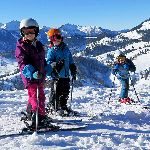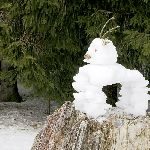Even more so, than with adults, the overall experience is what counts when ski touring with children. Sure, kids can be up for the challenge, but they should not be overloaded, they should be motivated, made curious, and need enough time for fun and games.
The first tour is often the key to success. Here you can get it right, but you can also really bugger it up. Not to worry though: With the following pointers, you are sure to have a blast in the snow with your kids!
Good ski touring conditions with children
The weather and snow play a decisive role. Don’t schedule the first tour too rigidly, stay as flexible as possible in your planning. Sunshine and excellent visibility are great, but even light snowfall can have its charms. It only gets unpleasant when the foehn storm almost knocks you over with every step you take or when sub-zero temperatures dictate the pace – and don’t allow for adequate breaks to be taken.

The avalanche danger should be so low on your first ski tour with a child that you can ignore it. A tour under tension is only half as much fun and can cause unnecessary anxiety.
Snow is most enjoyable when it is fresh and soft. Not only is the descent easier, but the little ones also have great fun making their own tracks in the fresh snow. But even solid snow that has been driven in like a piste is not necessarily a disadvantage as long as the tracks allow for comfortable skinning.
Tips for skinning: Spice it up!
Ideally, the skin track should be laid out in such a way that it winds its way upwards with as even a gradient as possible. Gentle alpine pasture terrain or a moderately sloping mountain ridge is particularly suitable here. If the existing track is too steep or too icy, you should create your own “child-friendly” track, and go break some trail.
Make the track deliberately playful. They will be surprised when they suddenly have to take a lap of honour around a tree or a boulder. Most children enjoy leading the ski tour in guide mode themselves if the terrain permits.
A chill pace and enough rest
Important for a ski tour with children is to have plenty of rest time – for eating, playing, discovering and a steady, comfortable pace while walking. If kids are not hungry or thirsty, they are quite capable of surviving a long “dry spell” without a break – it just needs to be adventurous.
Many games can easily be integrated into skinning. For example, the fitter ones in the group can get rid of their excess energy by building path markers for those who follow. Piles of snow or snow towers can be set up in no time at all using a handy shovel and can even be decorated with material from the forest. Spotting them on the way up can really be a lot of fun for all parties involved.

Of course, no ski tour with children should be without a longer break, no matter whether it takes place directly at the summit, a little below – to protect against the wind – or at any turning point of the tour. The main thing is that you make yourself comfortable and don’t just gobble down your bar whilst standing. A particularly nice idea, which combines building, playing, and eating together in a wonderful way, is a snow buffet. You build a large table of snow, where you arrange bite-sized pieces of apple, cucumber, carrot, bread, sausage, cheese and co. in colourful shapes and patterns.
Tips for the descent
Thus, well strengthened, we start the descent. This should also be chosen by the terrain so that everyone can descend without fear. Narrow passages, extremely steep slopes or dense forest are not suitable for children. In most cases, you will probably just take the way up and follow your tracks down.
Where the terrain permits, a “traverse” of the summit has a special charm, making for a varied tour. It is often worth taking a look at the map, because a descent “down the back” may have some quality pockets of powder left over.
If the conditions for riding are difficult, it has proved to be a good idea to ski in a lane with children. This means adult skis in front and the children follow this line at safe distances. In this way, they are relieved of the decision of the ideal place to change direction – and all of them reach the valley with significantly fewer falls and still at an adequate pace.

How long? How far?
There is no non-plus-ultra in terms of the length of the tour. Of course, the first children’s ski tour should not have an altitude difference of 1,200 metres. On average you can probably say that 400 to 500 metres of altitude difference are sufficient for the beginning. However, if the general conditions such as group, weather, terrain and breaks are right and the atmosphere is good, older children are quite capable of mastering 700 metres of altitude difference.
How old should kids be?
In general, ski touring is recommended from around eight years of age, depending on physical and motoric condition. There may well be fit and motivated children who start their first small ski tour at the age of six – provided they can ski sufficiently well. However, 300 metres of altitude difference is sufficient to give the little ones their first taste of ski touring, without putting them off for life.
What gear do children need on ski tours?
A lot has happened in recent years with regard to the gear available to kids.
- Avalanche beacons: As far as safety is concerned, every child should of course be equipped with a functioning avalanche transceiver. There are reasonably priced entry-level devices (e.g. the DSP Sport from Pieps). This is primarily a matter of keeping them safe. Of course, you can integrate the search function playfully in a days ski touring if the kids seem up for it.
- Shovel and probe are part of the basic equipment of a ski tourer but are not absolutely necessary for children on their first tours. On the one hand, because they are often not yet able to actively search, and on the other hand, because the backpack is often too small for the entire gear. Still sometimes having a shovel on board can be fun, especially when building snowmen is concerned.
- Functional clothing: Breathable, water-repellent functional clothing that can be combined into several layers using the layering principle is a matter of course.
- Backpack and food: A backpack suitable for children to carry their drinking bottle and snacks is also part of the luggage.

- Ski boots & binding sets: There are no limits to your personal inventiveness, depending on your budget. Usually, the children’s skis and boots are used at the beginning. You can either use a binding insert (Securafix), which is available in many AV sections in rental shops, or you can mount a children’s ski touring binding on the piste skis. Children’s touring skis are even more professional. If you want to do something good for your child’s feet, buy a touring boot as soon as the shoe size allows, or a children’s freeride shoe with a walking function.
- Climbing skins can be cut from old skins to fit the children’s skis or you can buy new, inexpensive ski skins.
- Ski poles: For the ascent, the children’s ski poles do it, or even better, because their length is adjustable: light children’s telescopic poles.
- Helmet and ski goggles: For the downhill run, parents should, of course, pack a ski helmet and ski goggles for their children.
- Alternatively, snowshoes: Small children who really want to get a taste of what’s to come can also take the first tour with children’s snowshoes. The alpine skis and boots for the downhill run are then carried up by mum or dad and exchanged for snowshoes at the summit.
More fun – more children
By the way, kids have more fun when other kids come along. Being the only child on an adult tour is – at least for the first time – not nearly as motivating and fun as being with some piers. Family groups, children’s and youth groups of the Alpine Club or private tours with like-minded friends are the best bet – provided that this will be possible in the upcoming “Corona winter”.
Such a constellation, just makes it so much easier to ensure the kid’s first experience of the outback will be a success. Children always need sufficient opportunities to play in order to pursue their urge to explore, for example by following animal tracks. Of course, breaks are particularly suitable for this. By the way, parents should not be surprised if their supposedly “exhausted” children do not just sit quietly and eat their snack during the breaks, but get active again immediately and start digging in the snow. This is their way of regeneration and should be perfectly acceptable.
Together with peers, ski touring is more fun – especially on a playful treasure hunt during the break. | Photo: Ulrike Heidinger


